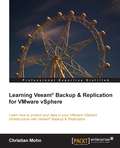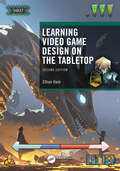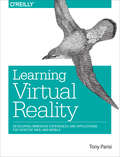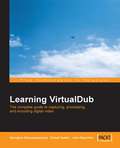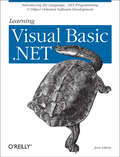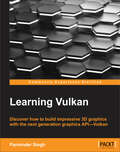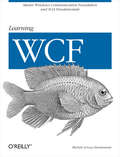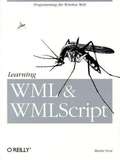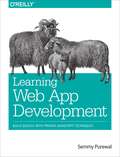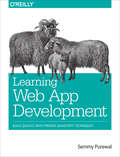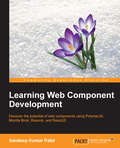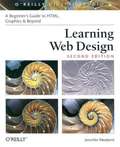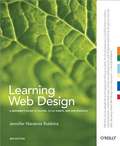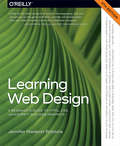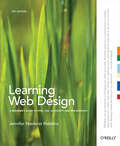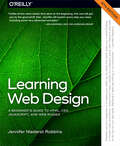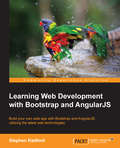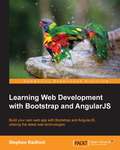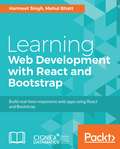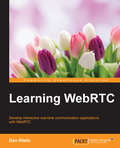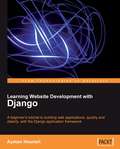- Table View
- List View
Learning Veeam® Backup & Replication for VMware vSphere
by Christian MohnThis is an easy-to-follow guide that will help you learn everything you need to know to administer backup, replication, and recovery in your VMware vSphere environment, with Veeam Backup and Replication. This book is aimed at VMware vSphere administrators looking to protect their infrastructure by utilizing the world's leading modern data protection solution, specifically designed for virtual environments. A good understanding of VMware vSphere architecture is recommended, but prior knowledge of Veeam Backup and Replication is not required.
Learning Video Game Design on the Tabletop
by Ethan HamLearn the mechanics that take your game from an idea to a playable product.Do you aspire to be a game designer but aren’t sure where to begin? Learning Video Game Design on the Tabletop guides you through your initial attempts to design game mechanics. It goes beyond simple description and definition to explore in detail the issues that designers grapple with for every game they create.Learning to design tabletop games builds a solid foundation for game designers and provides methods that can be applied towards creating paper prototypes of computer-targeted games. Presented in a step-by-step format, this book helps the reader understand how the game design skills that are acquired through creating tabletop games can be used when designing video games. Fully playable games accompany every topic so you can truly understand and experience each component that goes into game creation.The Second Edition includes: Simple, highly focused games that can be played, analyzed, improved, and/or modified in conjunction with a particular topic in the book Integrated game design exercises, chapter learning objectives, and in-text sidebars to provide further examples to apply directly to your game creation process Essays from professional tabletop and video game designers in which they describe their professional journeys and design philosophies.
Learning Virtual Reality: Developing Immersive Experiences and Applications for Desktop, Web, and Mobile
by Tony ParisiAs virtual reality approaches mainstream consumer use, a vibrant development ecosystem has emerged in the past few years. This hands-on guide takes you through VR development essentials for desktop, mobile, and browser-based applications. You’ll explore the three go-to platforms—OculusVR, Gear VR, and Cardboard VR—as well as several VR development environments, programming tools, and techniques.If you’re an experienced programmer familiar with mobile development, this book will help you gain a working knowledge of VR development through clear and simple examples. Once you create a complete application in the final chapter, you’ll have a jumpstart on the next major entertainment medium.Learn VR basics for UI design, 3D graphics, and stereo renderingExplore Unity3D, the current development choice among game enginesCreate native applications for desktop computers with the Oculus RiftDevelop mobile applications for Samsung’s Gear VR with the Android and Oculus Mobile SDKsBuild browser-based applications with the WebVR Javascript API and WebGLCreate simple and affordable mobile apps for any smartphone with Google’s Cardboard VRBring everything together to build a 360-degree panoramic photo viewer
Learning VirtualDub: The complete guide to capturing, processing and encoding digital video
by Sohail Salehi Georgios DiamantopoulosThis book is easy to read and fun. The examples and tutorials are short, focused and interesting. You can dip in and get what you want fast. This book is written by VirtualDub enthusiasts for new and intermediate users. It's ideal if you are just starting with video processing and want a powerful and free tool, or if you've already started with VirtualDub and want to take it further.
Learning Visual Basic .NET: Introducing the Language, .NET Programming & Object Oriented Software Development
by Jesse LibertyMost Visual Basic .NET books are written for experienced object-oriented programmers, but many programmers jumping on the .NET bandwagon are coming from non-object-oriented languages, such as Visual Basic 6.0 or from script programming, such as JavaScript. These programmers, and those who are adopting VB.NET as their first programming language, have been out of luck when it comes to finding a high-quality introduction to the language that helps them get started.That's why Jesse Liberty, author of the best-selling books Programming C# and Programming ASP.NET, has written an entry-level guide to Visual Basic .NET. Written in a warm and friendly manner, this book assumes no prior programming experience, and provides an easy introduction to Microsoft's most popular .NET language.Learning Visual Basic .NET is a complete introduction to VB.NET and object-oriented programming. This book will help you build a solid foundation in .NET, and show how to apply your skills by using hundreds of examples to help you become productive quickly. Learning Visual Basic .NET introduces fundamentals like Visual Studio .NET, a tool set for building Windows and Web applications. You'll learn about the syntax and structure of the Visual Basic .NET language, including operators, classes and interfaces, structs, arrays, and strings. Liberty then demonstrates how to develop various kinds of applications--including those that work with databases--and web services.By the time you've finished Learning Visual Basic .NET, you'll be ready to move on to a more advanced programming guide that will help you create large-scale web and Windows applications.Whether you have a little object-oriented programming experience or you are new to programming altogether, Visual Basic .NET will set you firmly on your way to mastering the essentials of the VB.NET language.
Learning Vue.js 2
by Olga FilipovaLearn how to build amazing and complex reactive web applications easily with Vue.js About This Book • Learn how to propagate DOM changes across the website without writing extensive jQuery callbacks code. • Learn how to achieve reactivity and easily compose views with Vue.js and understand what it does behind the scenes. • Explore the core features of Vue.js with small examples, learn how to build dynamic content into preexisting web applications, and build Vue.js applications from scratch. Who This Book Is For This book is perfect for novice web developer seeking to learn new technologies or frameworks and also for webdev gurus eager to enrich their experience. Whatever your level of expertise, this book is a great introduction to the wonderful world of reactive web apps. What You Will Learn • Build a fully functioning reactive web application in Vue.js from scratch. • The importance of the MVVM architecture and how Vue.js compares with other frameworks such as Angular.js and React.js. • How to bring reactivity to an existing static application using Vue.js. • How to use plugins to enrich your applications. • How to develop customized plugins to meet your needs. • How to use Vuex to manage global application's state. In Detail Vue.js is one of the latest new frameworks to have piqued the interest of web developers due to its reactivity, reusable components, and ease of use. This book shows developers how to leverage its features to build high-performing, reactive web interfaces with Vue.js. From the initial structuring to full deployment, this book provides step-by-step guidance to developing an interactive web interface from scratch with Vue.js. You will start by building a simple application in Vue.js which will let you observe its features in action. Delving into more complex concepts, you will learn about reactive data binding, reusable components, plugins, filters, and state management with Vuex. This book will also teach you how to bring reactivity to an existing static application using Vue.js. By the time you finish this book you will have built, tested, and deployed a complete reactive application in Vue.js from scratch. Style and approach This book is a thorough, step-by-step guide showing readers how to build complete web apps with Vue.js. While teaching its intricacies, this book shows how to implement the MVVM architecture in the real world and build high-performing web interfaces.
Learning Vue: Core Concepts and Practical Patterns for Reusable, Composable, and Scalable User Interfaces
by Maya ShavinLearn the core concepts of Vue.js, the modern JavaScript framework for building frontend applications and interfaces from scratch. With concise, practical, and clear examples, this book takes web developers step-by-step through the tools and libraries in the Vue.js ecosystem and shows them how to create complete applications for real-world web projects.You’ll learn how to handle data communication between components with Pinia architecture, develop a manageable routing system for a frontend project to control the application flow, and produce basic animation effects to create a better user experience.This book also shows you how to:Create reusable and lightweight component systems using Vue.jsBring reactivity to your existing static applicationSet up a project using Vite.js, a build tool for frontend project code managementBuild an interactive state management system for a frontend application with PiniaConnect external data from the server to your Vue applicationControl the application flow with static and dynamic routing using Vue RouterFully test your application using Vitest and Playwright
Learning Vulkan
by Parminder SinghDiscover how to build impressive 3D graphics with the next-generation graphics API—Vulkan About This Book • Get started with the Vulkan API and its programming techniques using the easy-to-follow examples to create stunning 3D graphics • Understand memory management in Vulkan and implement image and buffer resources • Get hands-on with the drawing process and synchronization, and render a 3D graphics scene with the Vulkan graphics pipeline Who This Book Is For This book is ideal for graphic programmers who want to get up and running with Vulkan. It's also great for programmers who have experience with OpenGL and other graphic APIs who want to take advantage of next generation APIs. A good knowledge of C/C++ is expected. What You Will Learn • Learn fundamentals of Vulkan programing model to harness the power of modern GPU devices. • Implement device, command buffer and queues to get connected with the physical hardware. • Explore various validation layers and learn how to use it for debugging Vulkan application. • Get a grip on memory management to control host and device memory operations. • Understand and implement buffer and image resource types in Vulkan. • Define drawing operations in the Render pass and implement graphics pipeline. • Manage GLSL shader using SPIR-V and update the shader resources with descriptor sets and push constants. • Learn the drawing process, manage resources with synchronization objects and render 3D scene output on screen with Swapchain. • Bring realism to your rendered 3D scene with textures, and implement linear and optimal textures In Detail Vulkan, the next generation graphics and compute API, is the latest offering by Khronos. This API is the successor of OpenGL and unlike OpenGL, it offers great flexibility and high performance capabilities to control modern GPU devices. With this book, you'll get great insights into the workings of Vulkan and how you can make stunning graphics run with minimum hardware requirements. We begin with a brief introduction to the Vulkan system and show you its distinct features with the successor to the OpenGL API. First, you will see how to establish a connection with hardware devices to query the available queues, memory types, and capabilities offered. Vulkan is verbose, so before diving deep into programing, you'll get to grips with debugging techniques so even first-timers can overcome error traps using Vulkan's layer and extension features. You'll get a grip on command buffers and acquire the knowledge to record various operation commands into command buffer and submit it to a proper queue for GPU processing. We'll take a detailed look at memory management and demonstrate the use of buffer and image resources to create drawing textures and image views for the presentation engine and vertex buffers to store geometry information. You'll get a brief overview of SPIR-V, the new way to manage shaders, and you'll define the drawing operations as a single unit of work in the Render pass with the help of attachments and subpasses. You'll also create frame buffers and build a solid graphics pipeline, as well as making use of the synchronizing mechanism to manage GPU and CPU hand-shaking. By the end, you'll know everything you need to know to get your hands dirty with the coolest Graphics API on the block. Style and approach This book takes a practical approach to guide you through the Vulkan API, and you will get to build an application throughout the course of the book. Since you are expected to be familiar with C/C++, there is not much hand-holding throughout the course of the book.
Learning WCF: A Hands-on Guide
by Michele Leroux BustamanteThis easy-to-use introduction to Microsoft Windows Communication Foundation (WCF) is ideal for developers who want to learn to build services on a company network or as part of an enterprise system. Built into Windows Vista and Longhorn, and available for Windows XP and Windows 2003, WCF provides a platform for service-oriented architecture (SOA) that enables secure and reliable communication among systems within an organization or across the Internet. With WCF, software developers can focus on their business applications and not the plumbing required to connect them. Furthermore, with WCF developers can learn a single programming API to achieve results previously provided by ASMX, Enterprise Services and .NET Remoting. Learning WCF removes the complexity of using this platform by providing detailed answers, explanations and code samples for the most common questions asked by software developers.Windows Communication Foundation (or WCF, formerly code name "Indigo") provides a set of programming APIs that make it easy to build and consume secure, reliable, and transacted services. This platform removes the need for developers to learn different technologies such as ASMX, Enterprise Services and .NET Remoting, to distribute system functionality on a corporate network or over the Internet. The first truly service-oriented platform, WCF provides innovations that decouple service design and development from deployment and distribution - creating a more flexible and agile environment. WCF also encapsulates all of the latest web service standards for addressing, security, reliability and more.
Learning WML & WMLScript
by Martin FrostThe next generation of mobile communicators is here, and delivering content to them will mean programming in WML (Wireless Markup Language) and WMLScript, the languages of the Wireless Application Environment (WAE). The WAE allows information in almost all applications to be formatted for display on mobile devices, such as cell phones, and enables the user to interact with the information. Why learn yet another technology? According to some estimates, 75 percent of web document viewing by the year 2002 will be through non-desktop devices, many using wireless technologies. Clearly, the future is wireless. For web developers who want to get up to speed quickly in these languages, Learning WML & WMLScript maps out in detail the WAE and its two major components, WML and WMLScript. Fortunately, the WAE provides a World Wide Web-like model for writing applications, incorporating several key features of the Web to ease the transition for developers. Almost all wireless applications can be written with WML, which replaces HTML in the wireless environment, and WMLScript, which replaces JavaScript. With this book, web developers with some knowledge of programming and C, Java, or JavaScript syntax can easily master both languages. Chapter by chapter, Learning WML & WMLScript takes readers through the following WML topics: *Decks, templates and cards *User Interaction *Variables and contexts *Tasks, events, and timers *Text and text formatting *Data types, conversions and variables *Operators and expressions *Statements *Functions *Standard libraries. WMLScript topics include: Learning WML & WMLScript is the resource of choice for application developers who want to upgrade their skills and their sites so they won't be left plugged in during the wireless revolution.
Learning Web App Development
by Semmy PurewalGrasp the fundamentals of web application development by building a simple database-backed app from scratch, using HTML, JavaScript, and other open source tools. Through hands-on tutorials, this practical guide shows inexperienced web app developers how to create a user interface, write a server, build client-server communication, and use a cloud-based service to deploy the application. Each chapter includes practice problems, full examples, and mental models of the development workflow. Ideal for a college-level course, this book helps you get started with web app development by providing you with a solid grounding in the process. Set up a basic workflow with a text editor, version control system, and web browser Structure a user interface with HTML, and include styles with CSS Use JQuery and JavaScript to add interactivity to your application Link the client to the server with AJAX, JavaScript objects, and JSON Learn the basics of server-side programming with Node. js Store data outside your application with Redis and MongoDB Share your application by uploading it to the cloud with CloudFoundry Get basic tips for writing maintainable code on both client and server
Learning Web App Development
by Semmy PurewalGrasp the fundamentals of web application development by building a simple database-backed app from scratch, using HTML, JavaScript, and other open source tools. Through hands-on tutorials, this practical guide shows inexperienced web app developers how to create a user interface, write a server, build client-server communication, and use a cloud-based service to deploy the application.Each chapter includes practice problems, full examples, and mental models of the development workflow. Ideal for a college-level course, this book helps you get started with web app development by providing you with a solid grounding in the process.Set up a basic workflow with a text editor, version control system, and web browserStructure a user interface with HTML, and include styles with CSSUse JQuery and JavaScript to add interactivity to your applicationLink the client to the server with AJAX, JavaScript objects, and JSONLearn the basics of server-side programming with Node.jsStore data outside your application with Redis and MongoDBShare your application by uploading it to the cloud with CloudFoundryGet basic tips for writing maintainable code on both client and server
Learning Web App Development: Build Quickly with Proven JavaScript Techniques
by Semmy PurewalGrasp the fundamentals of web application development by building a simple database-backed app from scratch, using HTML, JavaScript, and other open source tools. Through hands-on tutorials, this practical guide shows inexperienced web app developers how to create a user interface, write a server, build client-server communication, and use a cloud-based service to deploy the application.Each chapter includes practice problems, full examples, and mental models of the development workflow. Ideal for a college-level course, this book helps you get started with web app development by providing you with a solid grounding in the process.Set up a basic workflow with a text editor, version control system, and web browserStructure a user interface with HTML, and include styles with CSSUse JQuery and JavaScript to add interactivity to your applicationLink the client to the server with AJAX, JavaScript objects, and JSONLearn the basics of server-side programming with Node.jsStore data outside your application with Redis and MongoDBShare your application by uploading it to the cloud with CloudFoundryGet basic tips for writing maintainable code on both client and server
Learning Web Component Development
by Sandeep Kumar PatelThis book is the perfect reference for any web developer looking for an introduction to the new tools and techniques used to create web components.
Learning Web Design, 2nd Edition
by Jennifer Niederst RobbinsIn Learning Web Design , author Jennifer Niederst shares the knowledge she's gained from years of web design experience, both as a designer and a teacher. This book starts from the beginning-- defining the Internet, the Web, browsers, and URLs -- so you don't need to have any previous knowledge about how the Web works. After reading this book, you'll have a solid foundation in HTML, graphics, and design principles that you can immediately put to use in creating effective web pages. In the second edition, Jennifer has updated the book to cover style sheets and reflect current web standards. She has also added exercises that help you to learn various techniques and short quizzes that make sure you're up to speed with key concepts. The companion CD-ROM contains material for all the exercises in the book, as well as trial versions of Fireworks MX, and HomeSite 5; Adobe Photoshop 7, ImageReady 7, and BBEdit 7.* Learning Web Design , 2nd Edition: Covers the nuts and bolts of basic HTML and style sheets, with detailed examples of formatting text, adding graphic elements, making links, creating tables and frames, and using color on the Web. Explains whether to use GIFs or JPEGs for different types of images, and includes important tips on optimizing graphics for web delivery. Provides dozens of web design do and don'ts, to help you make good web design decisions and avoid common beginner traps. Contains hands-on exercises throughout the book that allow you to try out new techniques along the way. Unlike other beginner books, Learning Web Design leaves no holes in your education. It gives you everything you need to create basic web sites and will prepare you for more advanced web work. If you are interested in web design, this book is the place to start. After finishing it, you'll be ready for the author's bestselling companion reference, Web Design in a Nutshell . * Fireworks and HomeSite are trademarks or registered trademarks of Macromedia, Inc. in the United States and/or other countries. Adobe, ImageReady, and Photoshop are either registered trademarks or trademarks of Adobe Systems Incorporated in the United States and/or other countries.
Learning Web Design, Third Edition
by Jennifer Niederst RobbinsEverything you need to know to create professional web sites is right here. Learning Web Design starts from the beginning -- defining how the Web and web pages work -- and builds from there. By the end of the book, you'll have the skills to create multi-column CSS layouts with optimized graphic files, and you'll know how to get your pages up on the Web.
Learning Web Design: A Beginner's Guide to HTML, CSS, JavaScript, and Web Graphics
by Jennifer RobbinsDo you want to build web pages but have no prior experience? This friendly guide is the perfect place to start. You’ll begin at square one, learning how the web and web pages work, and then steadily build from there. By the end of the book, you’ll have the skills to create a simple site with multicolumn pages that adapt for mobile devices.Each chapter provides exercises to help you learn various techniques and short quizzes to make sure you understand key concepts.This thoroughly revised edition is ideal for students and professionals of all backgrounds and skill levels. It is simple and clear enough for beginners, yet thorough enough to be a useful reference for experienced developers keeping their skills up to date.Build HTML pages with text, links, images, tables, and formsUse style sheets (CSS) for colors, backgrounds, formatting text, page layout, and even simple animation effectsLearn how JavaScript works and why the language is so important in web designCreate and optimize web images so they’ll download as quickly as possibleNEW! Use CSS Flexbox and Grid for sophisticated and flexible page layoutNEW! Learn the ins and outs of Responsive Web Design to make web pages look great on all devicesNEW! Become familiar with the command line, Git, and other tools in the modern web developer’s toolkitNEW! Get to know the super-powers of SVG graphics
Learning Web Design: A Beginner's Guide to HTML, CSS, JavaScript, and Web Graphics (Oreilly And Associate Ser.)
by Jennifer RobbinsDo you want to build web pages, but have no previous experience? This friendly guide is the perfect place to start. You’ll begin at square one, learning how the Web and web pages work, and then steadily build from there. By the end of the book, you’ll have the skills to create a simple site with multi-column pages that adapt for mobile devices.Learn how to use the latest techniques, best practices, and current web standards—including HTML5 and CSS3. Each chapter provides exercises to help you to learn various techniques, and short quizzes to make sure you understand key concepts.This thoroughly revised edition is ideal for students and professionals of all backgrounds and skill levels, whether you’re a beginner or brushing up on existing skills.Build HTML pages with text, links, images, tables, and formsUse style sheets (CSS) for colors, backgrounds, formatting text, page layout, and even simple animation effectsLearn about the new HTML5 elements, APIs, and CSS3 properties that are changing what you can do with web pagesMake your pages display well on mobile devices by creating a responsive web designLearn how JavaScript works—and why the language is so important in web designCreate and optimize web graphics so they’ll download as quickly as possible
Learning Web Design: A Beginner's Guide to HTML, CSS, JavaScript, and Web Images
by Jennifer RobbinsDo you want to build web pages but have no prior experience? This friendly guide is the perfect place to start. You'll begin at square one, learning how the web and web pages work, and then steadily build from there. By the end of the book, you'll have the skills to create a simple site with multicolumn pages that adapt for mobile devices. Each chapter provides exercises to help you learn various techniques and short quizzes to make sure you understand key concepts. This thoroughly revised sixth edition is ideal for students and professionals of all backgrounds and skill levels. It's simple and clear enough for beginners yet thorough enough to be a useful reference for experienced developers keeping their skills up-to-date. Build HTML pages with text, links, images, tables, and forms Use style sheets (CSS) for formatting text, colors, backgrounds, page layout, and simple animation effects Use CSS Flexbox and Grid Layout for sophisticated and flexible page designs Learn the ins and outs of responsive web design to make web pages look great on all devices Get an introductory lesson in JavaScript programming, and use it to add functionality to web pages Understand the ways in which JavaScript has become central to the web development workflow Create and optimize web images so they'll download as quickly as possible Get to know the superpowers of the SVG format </p? The sixth edition features a completely rewritten and expanded JavaScript section written by Aaron Gustafson that provides more opportunities to practice writing code.
Learning Web Development with Bootstrap and AngularJS
by Stephen RadfordWhether you know a little about Bootstrap or AngularJS, or you're a complete beginner, this book will enhance your capabilities in both frameworks and you'll build a fully functional web app. A working knowledge of HTML, CSS, and JavaScript is required to fully get to grips with Bootstrap and AngularJS.
Learning Web Development with Bootstrap and AngularJS
by Stephen Radford<P><P>Build your own web app with Bootstrap and AngularJS, utilizing the latest web technologies <P><P>About This Book <P><P>Build, develop, and customize your application using Angular.js and Bootstrap <P><P>Utilize AngularStrap to pull in Bootstrap's jQuery plugins through Angular directives <P><P>Packed with tips to help you avoid potential stumbling blocks while developing <P><P>Who This Book Is For <P><P>Whether you know a little about Bootstrap or AngularJS, or you're a complete beginner, this book will enhance your capabilities in both frameworks and you'll build a fully functional web app. A working knowledge of HTML, CSS, and JavaScript is required to fully get to grips with Bootstrap and AngularJS. <P><P>What You Will Learn <P><P>Explore Angular's built-in filters and create your own <P><P>Create a multi-view web app using AngularJS's router and templating system <P><P>Integrate AngularStrap to utilize the many plugins originally created by the Bootstrap team <P><P>Customize Bootstrap using Less to create a unique theme <P><P>Maintain the codebase of your app using the gulp and Grunt.js task-runner tools <P><P>Discover the meaning of CRUD and how to implement it <P><P>Troubleshoot any issues you may encounter while developing <P><P>In Detail <P><P>If you're ready to progress your web development skills past HTML and CSS, this book will give you everything you need to build your own web app. You'll be taught the basics of Bootstrap and AngularJS, taking an in-depth look at what makes up each framework. After you've mastered the ideology, you'll put it into action as you build a contact manager throughout the course of the book. <P><P>We'll look at filters, routing, and views for your app and will teach you to utilize CRUD (Create, Read, Update, and Delete) to develop further. You'll learn how to connect your app to the server, customize Bootstrap, and build a directive. Along the way we'll touch on additional technologies such as Less, gulp, Grunt, and AngularStrap. Finally, we'll take a look at potential stumbling blocks and will give you tips to avoid them. <P><P>With this step-by-step guide packed with plenty of screenshots, you'll be building web apps in no time.
Learning Web Development with React and Bootstrap
by Harmeet Singh Mehul BhattBuild real-time responsive web apps using React and Bootstrap About This Book • Showcase the power of React-Bootstrap through real-world examples • Explore the benefits of integrating React with various frameworks and APIs • See the benefits of using the latest frameworks to make your web development experience enchanting Who This Book Is For This book is for anybody who is interested in modern web development and has intermediate knowledge of HTML, CSS, and JavaScript. Basic knowledge of any JavaScript MVC framework would also be helpful. What You Will Learn • See how to integrate Bootstrap with React • Explore the Redux architecture and understand its benefits • Build a custom responsive theme with React-Bootstrap components • Easily interact with DOM on your web browser • Appreciate the advantages of using JSX • Get acquainted with the various routing methods in React • Integrate external APIs into React In Detail Bootstrap is one of the most popular front-end frameworks, and integrating it with React allows web developers to write much cleaner code. This book will help you gain a thorough understanding of the Bootstrap framework and show you how to build impressive web apps. In this book, you will get an overview of the features of Bootstrap and ReactJS, along with the integration of React-Bootstrap components with ReactJS. You will understand the benefits of using JSX and the Redux architecture. The server-side rendering of React will also be shown. All the concepts are explained by developing real-world examples. By the end of this book, you will be equipped to create responsive web applications using Bootstrap style and React-Bootstrap components with ReactJS, and will have an insight into the best practices. Style and approach The mission is to help you make a live and fully-responsive web application using React-Bootstrap with hands-on examples and step-by-step instructions. This book is linear as well as progressive, so every chapter builds upon the knowledge gained in the last.
Learning WebRTC
by Dan RisticIf you are a web developer who wants to create well designed WebRTC applications for your users, this is the book for you. Even if you are early in your web development career, this book aims to provide a complete understanding of the WebRTC API. It is assumed that you have previous exposure to web development using HTML5 and JavaScript technologies.
Learning Website Development with Django
by Ayman HouriehBeing a beginner's guide this book has a very simple and clear approach. It is a practical guide that will help you learn the features of Django and help you build a dynamic website using those features. This book is for web developers who want to see how to build a complete site with Web 2.0 features, using the power of a proven and popular development system, but do not necessarily want to learn how a complete framework functions in order to do this. Basic knowledge of Python development is required for this book, but no knowledge of Django is expected.
